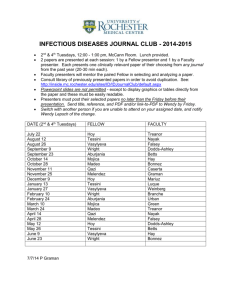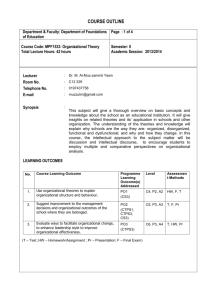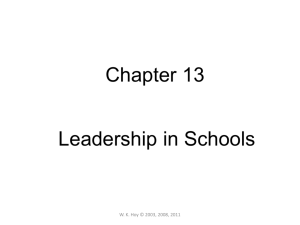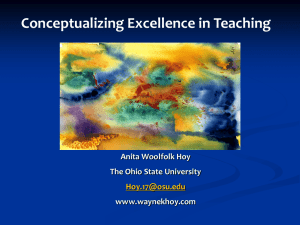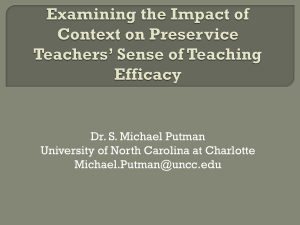External Environments and Accountability of Schools
advertisement
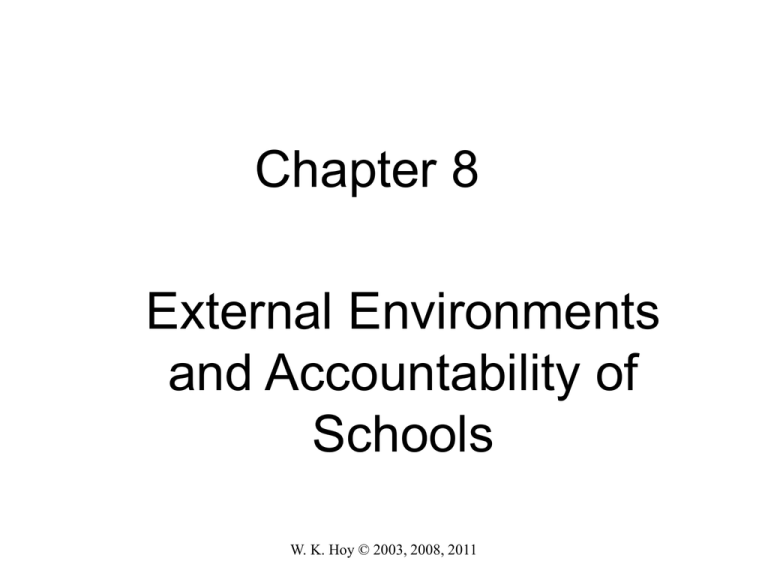
Chapter 8 External Environments and Accountability of Schools W. K. Hoy © 2003, 2008, 2011 Selected External Influences and Constituencies for School Districts Political and Legal Patterns Demographic Characteristics Taxpayers Societal Conditions Parents Unions School District Colleges/ Universities Educational Associations Economic and Market Forces Regulatory Agencies Legislatures Accrediting Agencies Information Technologies W. K. Hoy © 2003, 2008, 2011 Cultural Values Two Perspectives on Environments Resource-Dependence Perspective – Environmental resources: Fiscal, Personnel, Information, Products – Environmental resources: Simple or Complex – Availability of resources: Scarce to Munificence – Dependence: Need and Availability – Decision makers: View the environment as a place to gain scarce resources for the organization Institutional Perspective – Limited emphasis on goals, effectiveness, and efficiency – Schools: Constrained by other institutions of society – Administrators: Constrained by broader institutions W. K. Hoy © 2003, 2008, 2011 Resource-Dependence Perspective • Dependence is characterized as the extent of the need for a resource and its availability. • It is directly related to the need for resources controlled by other organizations. • Suppliers gain power to decide whether schools get resources they need and determine if the schools can use the resources the way they want. • If organizations are unable to generate resources internally, they must enter into external exchanges which may consume vital resources and/or demand changes from the organization. (Pfeffer, 1982, 1997) W. K. Hoy © 2003, 2008, 2011 Resource-Dependence Perspective Resource Continuum Scarcity • • • Munificence • • Competition for resources is fierce Zero-sum game Limited to basic academic and extracurricular programming • W. K. Hoy © 2003, 2008, 2011 Survival is easy Pursue wide-ranging goals Abundant curricular and extracurricular programs Administering Task Environments Uncertainty and dependency threaten or constrain autonomy and drive change; thus, organizations must cope. Coping Strategies: – Buffering – Planning and forecasting – Boundary spanning – Adjusting operations – Accommodating structure W. K. Hoy © 2003, 2008, 2011 The Environment-Structure Fit Change the Structure to fit the Environment – If the environment is stable, a mechanistic structure is an effective accommodation. – If the environment is unstable, then an organic structure is the better fit – If the environment is stable and the organizational structure is organic, a dysfunctional flexibility emerges. – If the environment is unstable and the structure is mechanistic, a dysfunctional rigidity is produced. W. K. Hoy © 2003, 2008, 2011 Accommodating Structure to Environmental Change W. K. Hoy © 2003, 2008, 2011 Administering Task Environments Inter-organizational coping strategies – Partnerships – Cooptation – Political lobbying – Pooling resources W. K. Hoy © 2003, 2008, 2011 Institutional Perspective • Institutions are more or less agreedupon set of rules that carry meaning for and determine the actions of some population of actors. • Institutional environments are symbolic and cultural in nature. • Important ideas include conformity, diversity, and stability W. K. Hoy © 2003, 2008, 2011 Institutional Perspective Types of Conformity – Coercive – pressures of government mandates and inducements – Imitative – adopting standard responses from other sources to reduce uncertainty and gain legitimacy – Normative – professional standards and codes are spread across organizations W. K. Hoy © 2003, 2008, 2011 Institutional Perspective Stabilizing forces in education: – Centralized government, professional associations, and coalitions standardize operating procedures and provide stability (Meyer & Rowan, 1977) – Environmental demands, characteristics of inputs and outputs, technical processes brought under jurisdiction of institutional meanings and control – Support guaranteed by agreements rather than dependent upon performance. W. K. Hoy © 2003, 2008, 2011 Administering Institutional Environments Buffering strategies – Decoupling – Managing the image Boundary-spanning strategies – Categorical conformity – Structural conformity – Procedural conformity © Hoy, 2003 Educational Administration Accountability Accountability plans generally include three components: • Standards to identify the subject matter knowledge and skills to be learned. • Tests aligned with the standards. • Consequences of differing levels of goal attainment. W. K. Hoy © 2003, 2008, 2011 Accountability and Reform The drive for accountability is based on three underlying principles: • Schools should be held accountable for higher standards of performance. • Schools should be provided assistance to build their capacities for delivering improved education. • Schools must increase the quality and quantity of their performance outcomes, especially student achievement. W. K. Hoy © 2003, 2008, 2011 Federal Reform Initiatives The No Child Left Behind Act • AYP—Academic Yearly Progress • EBP—Evidence-Based Practice • Scientifically-Based Research to inform practice Race to the Top • Adopting Standards • Building Data Systems • Recruiting and developing effective teachers and principals • Turning around our lowest achieving schools. W. K. Hoy © 2003, 2008, 2011 Campbell’s Law The more any quantitative social indicator is used for social decision making, the more it will distort and corrupt the very social processes it is intended to monitor. Early-warning testing in elementary schools may push out students who are likely to fail the test because both the school and students believe that these students are a poor bet for finishing high school. This is good example of looking good but failing. If accountability practices are to be effective, they must shun short-term successes in favor of rigorous systemic changes that actually improve schools. W. K. Hoy © 2003, 2008, 2011 Practical Imperatives • • • • • • • • • • Keep organizational structures flexible: It is imperative to respond quickly to environmental constraints. Nurture healthy relations with local groups and agencies: Parental groups and local organizations are important aspects of the immediate environment. Engage the environment: It presents both constraints and opportunities. Develop internal and external coping strategies: Buffering and bridging are two general strategies to cope positively with the external environment. Recognize that schools are institutions: Schools mirror the norms, values, and ideology of the broader society. Develop fair accountability systems for teachers: Accountability is an organizational reality. Ensure that tests are aligned with standards: Clear and rational alignment limits conflict and improves success. Be open to constructive change: Change and reform are integral parts of contemporary schooling. Beware of the dysfunctional consequences of high-stakes testing: A focus on standardized test scores can encourage cheating and limit poor students’ prospects for success. Seek abstract resources such as neighborhood affiliations or school culture: Abstract resources are more potent than simple ones in school improvement. W. K. Hoy © 2003, 2008, 2011
